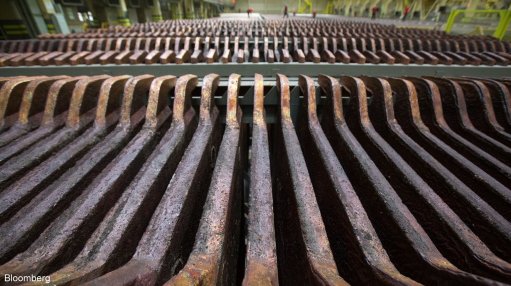Pan African advancing to quarter million ounces of gold a year, analyst calculates

Pan African CEO Cobus Loots interviewed by Mining Weekly's Martin Creamer. Video: Darlene Creamer
JOHANNESBURG (miningweekly.com) – The pathway established by Pan African Resources towards achieving gold production of a quarter million ounces a year in 2026 is based on two organic growth prospects in the immediate future, Edison Investment stated in research released on Monday, September 18.
The two organic growth projects named are the Mintails Soweto Cluster, near Krugersdorp and Mogale on the West Rand, and Royal Sheba, in the Barberton area of Mpumalanga.
Beyond these, the London- and Johannesburg-listed gold mining company headed by Cobus Loots has the Fairview sub-vertical shaft, Rolspruit, Poplar and Evander South assets available for potential development, stated Edison, which described the share valuation of Pan African as being “cheap by any measure”.
All conditions precedent for funding the Mintails/Mogale project, which is under construction, have been fulfilled and mine layout optimisation and scheduling have now been finalised at Royal Sheba.
Attainment by Pan African of a production of 250 000 oz in its 2026 financial year will push normalised headline earnings a share to around 6c a share, Edison forecasts.
Mining Weekly conducted this Zoom interview with Loots. (Also watch attached Creamer Media video.)
Mining Weekly: Is it likely that, for the foreseeable future, the full extent of Pan African’s South African asset base will be the Barberton, Evander and Mintails/Mogale complexes – or does considerable scope remain for Pan African to potentially take up additional surface and underground gold opportunities in addition to the three complexes?
Loots: We're in the fortunate position of not running out of mine life anytime soon on any of our assets. There's still tremendous scope at Barberton for expansion for new discoveries. At Evander, we have Elikhulu, one of the lowest-cost producers in Southern Africa producing at $1 000/oz all-in sustaining cost (AISC). We've been investing very heavily in the underground at Evander, on the 24 to 26 level project development, the last of the major capital to be spent in the year ahead. That will take the underground complex to a 13-year-plus life-of-mine. We estimate AISC there of $1 250/oz, which, again, is very competitive, both in South Africa and internationally. Then, our latest complex is Mintails/Mogale, where we’re building a world-class tailings retreatment operation, which will be commissioned by December 2024. With all of this ongoing, we don't have to go and do anything else.
In this modern age, when Pan African processes the gold from its underground mines, is it managing to recover 100% of that gold from the material that it processes – or is there still a volume of gold left in the residual that presumably goes on to existing tailings dams for later retreatment by yourselves or others?
In our run-of-mine mine treatment for gold, we cover as much as what we believe is economically feasible. We do leave behind, but generally the gold we leave behind is the gold we're not able to extract economically. You can extract 100% technically, theoretically, but it just doesn't make sense from a cost and timing perspective. If I look at our plants, we are quite proud of our metallurgical plant performance at Barberton, including the Biox process. Our recoveries are north of 92%. With Evander run-of-mine, we recover as much as 98% of the gold. Then on the tailings side, recoveries drop, but you need to bear in mind that on tailings you’re generally treating 3.3 g/t, which is obviously very low. We’re really happy with the performance of our metallurgical plants. Theoretically, one can extract 100%. It's just that at this point, it doesn't make business sense to do so.
When Pan African processes gold from its surface tailings retreatment operations, again, in this modern age, is Pan African managing to recover 100% of the gold in those tailings retreated – or is gold, once again, left in the material for which new disposal sites must be secured, presumably with increasing difficulty?
There is some level of gold there, but generally on tailings retreatment, we’re doing very well and we recover anywhere from 35% to 50% of the gold. The gold that remains, it’s fair to say, would almost be like a trace element in redepositing of something like 0.15 g/t, so that’s very, very low. Again, the processes are incredibly efficient. That's why on tailings retreatment we’re able to produce an AISC at circa $1 000/oz, both at Elikhulu and in terms of feasibility work at Mintails/Mogale. Again, you can recover a little bit more but it just doesn't make sense from an economic perspective.
Do Pan African’s current retreatment processes include the recovery of gold from tiny invisible picobubbles or nanobubbles or microbubbles generated during flotation, or does the gold in these form part of the material that is once again dumped?
Those would be very interesting theoretical papers to discuss and I'm sure that our metallurgists would also love discussing that but, again, we extract what we think is economical and certainly what the textbook demonstrates is economic and the rest of the material would go back on to tailings.
If the gold in these tiny invisible microbubbles is not being recovered, is Pan African aware of the proudly South African technology being deployed to recover the gold in these tiny invisible bubbles, in addition to all the other gold recovered conventionally?
Well, there's a big difference between doing something on a test basis and then having a scalable solution and that generally is the challenge of new technologies. We’re not adverse to looking at new technologies. As a matter of fact, at our Barberton tailings treatment plant in the last year, we managed to reduce reagent consumption and bring down costs by implementing some new technology, so we’re very happy to look at anything that's going to increase gold recoveries, improve our production, and the question normally is scalability on any new technology, something that works well in a lab and I don't want to define on these new recovery methodologies, but when you're treating a million tons a month, it's a very different scale, so that's what we would need to look at.
There are several sites where this new ten-year-life South African picobubble technology runs maintenance-free. How much maintenance downtime is required by the processing technology used by Pan African currently, what is the cost of such downtime to the company, and what is the cost to the company of the ongoing regular maintenance itself?
We run strict maintenance schedules on all our plants and those maintenance schedules are factored into our production guidance. Because we’re able to do a lot of planned maintenance on pretty much a monthly basis on all of our plants, that means the unexpected downtime is kept to a bare minimum. It's critical for such large-scale plants that ongoing maintenance is done to ensure that your equipment’s in fantastic shape, which is what we do. There's no technology in my mind that can negate the need for regular maintenance. Again, to the extent that there’s new proven technologies, we continue to look at those, but we’re quite happy that our plants are in very good state and that because of the maintenance schedules that we so rigorously hold to, our plants are running as efficiently as practicable at this point.
How much more gold could be recovered from tailings if maintenance were no longer required and to what extent would this lower your carbon footprint?
I just can’t see any scenario where no maintenance is required. The nature of the material and the scale of what happens means everything needs constant maintenance – your impellers, your tanks, your pumping systems, all of the other technologies and applications and at this point, practically I just don't think it's easy to get away from maintenance.
PICOBUBBLE TECHNOLOGY
As reported by Mining Weekly on September 15, there are said to be 15 companies that make use of the proudly South African maintenance-free MACH Reactor picobubble technology globally, one of them in South Africa, a platinum group metals (PGMs) operation.
Described as being a hydrodynamic cavitation reactor that generates the tiny invisible picobubbles, MACH is retrofitted on to existing plants, where it reportedly maximises recoveries, lowers reagent consumptions and reduces footprints.
As its underlying mechanism, MACH makes the power of cavitation and shockwaves available to the metallurgical industry, as well as to water treatment industries, for the treatment of acid mine drainage, for example, which helps towards creating a cleaner future.
Mining Weekly’s video and report on the South Africa-developed reactor can be accessed from this link: https://www.miningweekly.com/article/proudly-south-african-microbubble-technology-taking-mining-world-by-storm-2023-09-15
Comments
Press Office
Announcements
What's On
Subscribe to improve your user experience...
Option 1 (equivalent of R125 a month):
Receive a weekly copy of Creamer Media's Engineering News & Mining Weekly magazine
(print copy for those in South Africa and e-magazine for those outside of South Africa)
Receive daily email newsletters
Access to full search results
Access archive of magazine back copies
Access to Projects in Progress
Access to ONE Research Report of your choice in PDF format
Option 2 (equivalent of R375 a month):
All benefits from Option 1
PLUS
Access to Creamer Media's Research Channel Africa for ALL Research Reports, in PDF format, on various industrial and mining sectors
including Electricity; Water; Energy Transition; Hydrogen; Roads, Rail and Ports; Coal; Gold; Platinum; Battery Metals; etc.
Already a subscriber?
Forgotten your password?
Receive weekly copy of Creamer Media's Engineering News & Mining Weekly magazine (print copy for those in South Africa and e-magazine for those outside of South Africa)
➕
Recieve daily email newsletters
➕
Access to full search results
➕
Access archive of magazine back copies
➕
Access to Projects in Progress
➕
Access to ONE Research Report of your choice in PDF format
RESEARCH CHANNEL AFRICA
R4500 (equivalent of R375 a month)
SUBSCRIBEAll benefits from Option 1
➕
Access to Creamer Media's Research Channel Africa for ALL Research Reports on various industrial and mining sectors, in PDF format, including on:
Electricity
➕
Water
➕
Energy Transition
➕
Hydrogen
➕
Roads, Rail and Ports
➕
Coal
➕
Gold
➕
Platinum
➕
Battery Metals
➕
etc.
Receive all benefits from Option 1 or Option 2 delivered to numerous people at your company
➕
Multiple User names and Passwords for simultaneous log-ins
➕
Intranet integration access to all in your organisation



















